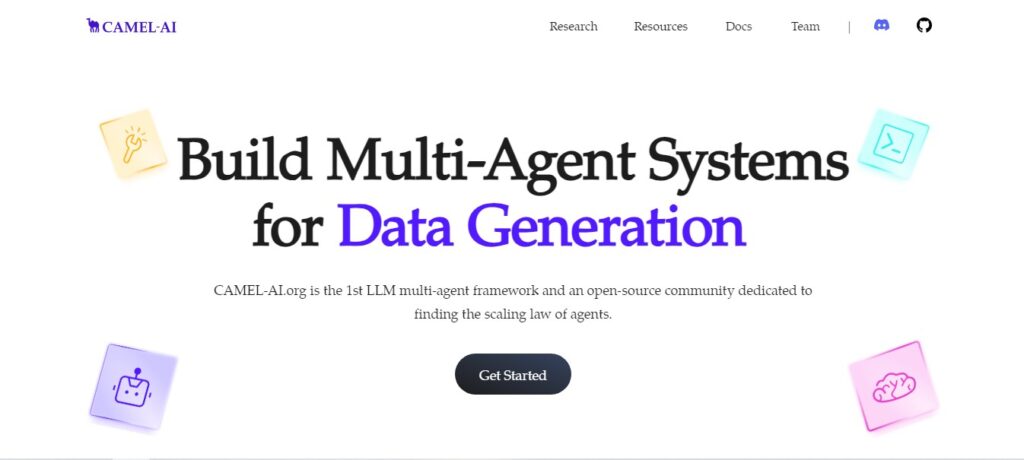CAMEL AI: Build Multi-Agent Systems with Large Language Models
CAMEL AI is a pioneering open-source framework that empowers developers to build and explore multi-agent systems driven by large language models (LLMs).
Website
Description
CAMEL AI is a pioneering open-source framework that empowers developers to build and explore multi-agent systems driven by large language models (LLMs). This innovative platform facilitates the creation of communicative agents capable of collaborating, automating tasks, and simulating complex scenarios.
CAMEL AI stands out as the first LLM multi-agent framework, providing a unique environment for researchers and developers to delve into the fascinating world of AI societies. Its open-source nature fosters community collaboration and accelerates advancements in the field of multi-agent systems.
How CAMEL AI Works:
- Utilizes LLMs as the core for individual agents, enabling natural language communication and complex reasoning.
- Provides a structured framework for defining agent roles, tasks, and interactions.
- Facilitates communication between agents through a shared message board.
- Allows for the creation of diverse scenarios and simulations to study emergent behavior and complex interactions.
Key Features and Functionalities:
- Open-source framework for building and experimenting with multi-agent systems.
- Leverages LLMs for advanced agent capabilities.
- Supports various communication protocols and interaction mechanisms.
- Provides tools for analyzing agent behavior and system performance.
- Facilitates the development of practical applications, such as task automation and data generation.
Use Cases and Examples:
- Task Automation: Create a team of agents to automate complex workflows, such as customer support, content creation, or data analysis.
- Data Generation: Generate synthetic data for training machine learning models or simulating real-world scenarios.
- World Simulations: Build virtual worlds populated by AI agents to study social dynamics, economic models, or environmental systems.
- Research and Development: Explore new frontiers in multi-agent systems, LLM capabilities, and emergent behavior.
- Education and Training: Provide a hands-on platform for students and researchers to learn about AI, multi-agent systems, and LLM interactions.
Examples:
- A team of agents collaborates to write different sections of a news article, with each agent specializing in a specific domain.
- Agents simulate a stock market environment, with each agent representing a different trader with unique strategies and risk tolerances.
User Experience:
While Camel focuses on facilitating human-AI interaction through natural language, its design and features suggest a user experience that prioritizes:
- Intuitive Communication: Camel allows users to interact with AI models in a conversational manner, using natural language prompts and receiving responses in a similar format. This intuitive approach makes it easy for users to communicate their needs and understand the AI's output.
- Exploration and Experimentation: The platform encourages users to explore the capabilities of different AI models and experiment with various prompts and tasks. This fosters a sense of discovery and allows users to learn about AI through hands-on interaction.
- Accessibility and Openness: Camel is an open-source project, making it accessible to a wide range of users, including researchers, developers, and enthusiasts. This openness promotes collaboration and contributes to the advancement of AI technology.
Pricing and Plans:
CAMEL AI is an open-source project and is freely available for anyone to use, modify, and contribute to.
Competitors:
- PettingZoo: A Python library for multi-agent reinforcement learning, while CAMEL AI focuses on LLM-based communicative agents.
- MAgent: A platform for simulating large-scale multi-agent scenarios, but CAMEL AI emphasizes the use of LLMs for agent intelligence.
- Ray: A distributed computing framework that can be used for multi-agent systems, but CAMEL AI provides a more specialized solution for LLM-based agents.
Unique Selling Points:
- First LLM multi-agent framework for exploring AI societies.
- Open-source platform that fosters community collaboration and innovation.
- Focus on communicative agents and complex interactions.
Last Words: Join the CAMEL AI community and explore the exciting world of multi-agent systems powered by large language models. Visit their website to download the framework, contribute to the project, and build your own AI society.

